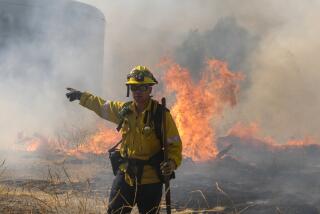1st Interstateâs Insurers Face a Complex and Costly Task
While fire inspectors sift the gutted floors of the First Interstate Bank building for the cause of Wednesday nightâs fire, insurance officials joined them Friday to try to place liability for the anticipated deluge of loss claims. These will likely run into the tens if not hundreds of millions of dollars, insurance experts say.
The bank owns the 62-story tower in partnership with Equitable Life Assurance Society. Equitableâs real estate subsidiary manages the 1-million-square-foot building, which has more than 100 different tenants, many of them law offices.
âAll I know is that our people say we are covered,â said Jonathan Miller, spokesman for Equitable Real Estate in New York.
Miller said the primary insurers for the building are Insurance Co. of North America--the insurance subsidiary of Cigna, one of the nationâs largest insurance holding companies--and by Continental Insurance Co. in New York.
A Cigna spokesman declined to outline the buildingâs coverage, saying the company does not discuss specific financial contracts. And Jill Sterling, spokeswoman for Continental, said the company insures the owners for some forms of liability but could not elaborate.
With no damage estimate yet released by the Los Angeles Fire Department and loss claims only beginning to be submitted, the magnitude of the insured liability remained anyoneâs guess. But it is sure to be hefty. When the building was constructed more than 16 years ago, its cost was estimated at $60 million.
Five years ago, after fire damaged Norwest Bankâs 16-story building in downtown Minneapolis, fire officials estimated the loss in property damage at $75 million, but the bank and its insurers contended that they had âprovable claimsâ of nearly $156 million. The claims, they said, included $88 million in lost rent from tenants and destroyed furnishings, plus $50 million in âactual business interruptionâ at Norwest.
The primary insurers in that case--St. Paul Mercury Insurance and St. Paul Fire & Marine--actually paid $64.7 million and then sought to recover damages from parties that it believed were responsible for causing the damage, including a company demolishing an adjacent building where the fire originated. (The case eventually was settled out of court, and the terms were not made public.)
In the much larger case of the First Interstate Bank building fire, âit will be extremely complexâ to unravel insurance responsibilities, Continentalâs Sterling said. âYou have many kinds of insurance involved in a building like this, and there are primary insurers and reinsurers sharing the total exposure.â
Moreover, the range of what can be insured, not only by the buildingâs owners but by its tenants, is immense, said Cary Stone, director of claims liability for Allstate Insurance in the Chicago suburb of South Barrington.
âCoverage of that magnitude is almost always written as a policy tailored to the specific needs of the building and its owner,â Stone said. âVery often, in a big building like that, there will be multiple insurers.
âSometimes coverage is placed in âlayers,â where one company has some of the risk and others provide coverage above that limit,â she explained. âA building that big represents a lot of exposureâ to financial risk. But the primary insurers, such as Insurance Co. of North America, will coordinate and pay claims on behalf of themselves and their reinsurers, later collecting from them for the part of the risk that they assumed in exchange for a share of the total premium payments.
How much of that total risk is assumed by the owners themselves also varies widely, Stone said. But typically, she said, one policy will cover the permanent structure, another the buildingâs machinery and any other property not owned by tenants. Such insurance also will protect the owners against lost income while the building is closed to customers and tenants alike.
Tenants are responsible for insuring their own furnishings and equipment, Stone said. Data-processing policies are available to cover computers and other equipment, and the replacement value of lost data--the time and money involved in reconstituting records--may be insured separately.
But many companies, such as First Interstate Bank, maintain computer operations in a separate building from headquarters, routinely making backup copies and arranging for alternative computers, she said. In such cases, âthe most they would have lost would be one dayâs transactions.â
In contrast to property insurance, liability coverage protects the buildingâs owner or its tenants--whoever buys the policy--from claims made against them, perhaps from neighbors or owners of cars damaged by smoke or acidic water.
âUntil you know whoâs at fault,â Stone said, âyou donât know who is going to pay. What routinely happens after a large fire like this or in a big hotel--remember the MGM Grand--liability claims will be made against not just the building owner and operator but against people who provided materials for or worked on the building.â
Workersâ compensation insurance would normally cover employees hurt or killed on the job, she added.
More to Read
Inside the business of entertainment
The Wide Shot brings you news, analysis and insights on everything from streaming wars to production â and what it all means for the future.
You may occasionally receive promotional content from the Los Angeles Times.










